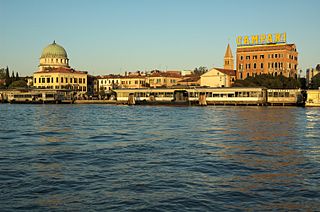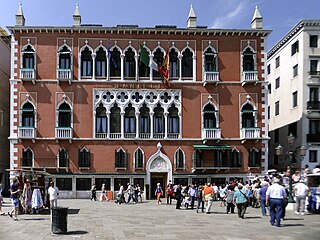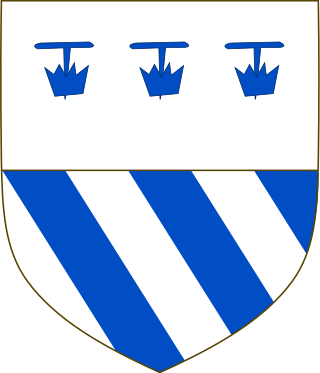
Venice is a city in northeastern Italy and the capital of the Veneto region. It is built on a group of 118 small islands that are separated by expanses of open water and by canals; portions of the city are linked by over 400 bridges. The islands are in the shallow Venetian Lagoon, an enclosed bay lying between the mouths of the Po and the Piave rivers. In 2020, around 258,685 people resided in greater Venice or the Comune di Venezia, of whom around 51,000 live in the historical island city of Venice and the rest on the mainland (terraferma). Together with the cities of Padua and Treviso, Venice is included in the Padua-Treviso-Venice Metropolitan Area (PATREVE), which is considered a statistical metropolitan area, with a total population of 2.6 million.

The Venetian Lagoon is an enclosed bay of the Adriatic Sea, in northern Italy, in which the city of Venice is situated. Its name in the Italian and Venetian languages, Laguna Veneta—cognate of Latin lacus, "lake"—has provided the English name for an enclosed, shallow embayment of salt water, a lagoon.

The Island of San Michele is an island in the Venetian Lagoon, Veneto, northern Italy. It is associated with the sestiere of Cannaregio, from which it lies a short distance northeast.

Murano is a series of islands linked by bridges in the Venetian Lagoon, northern Italy. It lies about 1.5 km (1 mi) north of Venice and measures about 1.5 km (1 mi) across with a population of just over 5,000. It is famous for its glass making. It was once an independent comune, but is now a frazione of the comune of Venice.

The Lido, or Venice Lido, is an 11-kilometre-long (7-mile) barrier island in the Venetian Lagoon, northern Italy; it is home to about 20,400 residents. The Venice Film Festival takes place at the Lido late August/early September.

The Grand Canal is a channel in Venice, Italy. It forms one of the major water-traffic corridors in the city.

The bucentaur was the ceremonial barge of the doges of Venice. It was used every year on Ascension Day up to 1798 to take the doge out to the Adriatic Sea to perform the "Marriage of the Sea" – a ceremony that symbolically wedded Venice to the sea.

San Michele in Isola is a Roman Catholic church, located on the Isola di San Michele, a small islet sited between Venice and Murano, which once sheltered a Camaldolese monastery, but now houses the main cemetery of the city. The monastery was mostly demolished in the 19th century, but the church remains, originally rebuilt starting in 1469. The church is dedicated to Saint Michael, the holder of the scales on Judgement Day, a fit guardian of the sleep of the faithful dead. The island cemetery now includes the land of the formerly separate island of San Cristoforo. This church is sometimes referred to as San Michele di Murano, although this islet is separate from islands comprising that town.
This article presents a detailed timeline of the history of the Republic of Venice from its legendary foundation to its collapse under the efforts of Napoleon.

The Hotel Danieli is a palatial five-star hotel in Venice, Italy. The central wing of the hotel was built as the Palazzo Dandolo at the end of the 14th century, by one of the Dandolo families. CNN cites it as one of the top five "lavish hotels" in the city.
The Church of San Clemente is a church built in 1131 and located on San Clemente Island, in the Venetian Lagoon. The name is dedicated to Pope Clement I, who died as a martyr according to legend and who is patron of seamen.
Giovanni Polani was Bishop of Castello, Italy, from 1133 to 1164. He was engaged in a long-running dispute over jurisdiction with Enrico Dandolo, the Patriarch of Grado.

The Diocese of Castello, originally the Diocese of Olivolo, is a former Roman Catholic diocese that was based on the city of Venice in Italy. It was established in 774, covering the islands that are now occupied by Venice. Throughout its existence there was tension between the diocese, the Patriarchate of Grado to which it was nominally subordinate, and the Doge of Venice. Eventually in 1451 the diocese and the patriarchate were merged to form the Archdiocese of Venice.
Andrea Cominelli was an Italian stonemason, sculptor and architect, who was active in the Republic of Venice during the second half of the 17th century.
Enrico Dandolo was Patriarch of Grado, Italy, from 1134 to 1182. A member of a noble Venetian Dandolo family, after his appointment he put the interests of the church ahead of all other concerns.

Nicolò Malermi was an Italian biblical scholar credited as the first translator of the Bible from Latin into the Italian language.
The following is a timeline of the history of the city of Venice, Veneto, Italy.

The Riva degli Schiavoni is a monumental waterfront in Venice. It is located in the sestiere of Castello and extends along the San Marco basin in the stretch from the Ponte della Paglia bridge, close to the Doge's Palace to the rio di Ca' di Dio.

The Moro family was a patrician family of the Republic of Venice.
This is an alphabetical index of people, places, things, and concepts related to or originating from the Republic of Venice. Feel free to add more, and create missing pages.













